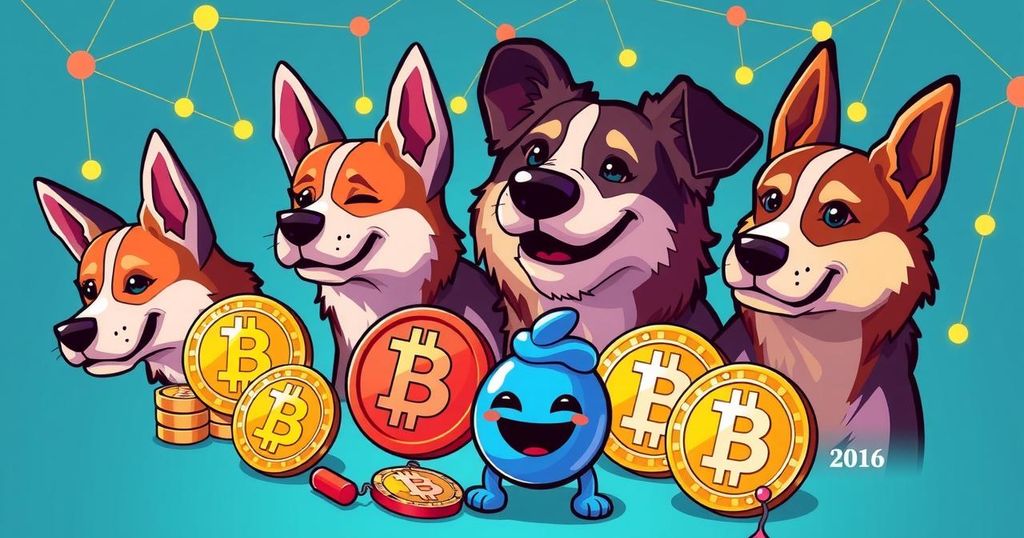Meme coin surge: Is this the dawn of a new crypto paradigm?
As the cryptocurrency market shifts dramatically, meme coins are becoming increasingly influential. In this article, we explore their rise and significance in today’s crypto landscape.
Meme Coins: The Transformative Players in Crypto Market
The cryptocurrency landscape is experiencing quite a tumultuous period, and meme coins—which used to be brushed off as frivolous—are becoming the focal point of a significant transformation. Coins like Shiba Inu (SHIB), Dogecoin (DOGE), and newer additions such as Pepe (PEPE) have seen remarkable surges, driven by technical breakouts, increasing institutional investments, and a burgeoning wave of innovation that marries meme-fueled speculation with practical blockchain applications. It’s more than just the same old hype reminiscent of the 2017 ‘dogecraze’; we are witnessing a fundamental shift towards more accessible and agile cryptocurrency systems.
Exploring Technical Indicators Driving Meme Coins
Let’s delve into the technical factors that underlie this meteoric rise, beginning with the action around Shiba Inu. On July 10, the SHIB/BTC pair broke through a triangular consolidation pattern, enjoying a notable uptick of 3.7%. This spike was accompanied by institutional buying, with volumes skyrocketing to a staggering 1.25 trillion tokens—five times higher than its usual daily volume. Moreover, as the MACD histogram shifted to a bullish position, there’s a major test occurring around the resistance level of $0.00001250. A sustained breakout here could propel SHIB toward $0.00001430—a promising 15% increase from current trading levels.
Dogecoin’s Resurgence Amid Bitcoin’s Rise
Similarly, Dogecoin is catching the wave. After forming a double bottom pattern at approximately $0.157 to $0.158 and witnessing whale accumulation soar by 112% in just one week, the bullish sentiment is palpable. On its 4-hour chart, an ascending triangle breakout sets a bullish target at $0.2030, while the structure hints at an even longer range that could reach $0.75. There’s an intricate dance happening between Bitcoin’s price movements—currently targeting $107,000—and the exuberance surrounding meme coins. Traders looking for better opportunities are shifting their focus from sluggish assets like Ethereum to meme coins that offer enticing chances for profit.
Institutional Investment: The New Frontier
However, it’s crucial to highlight that the meme coin obituaries are prematurely written; they have evolved from mere speculation. Significant institutional capital is piercing through to projects that combine meme culture with tangible utility. Take Snorter, a meme trading bot. It integrates with Telegram and facilitates features like copy trading, rug pull detection, and MEV protection, while expanding to EVM chains. Its staking rewards have shown a reduction from an eye-popping 767% to a more balanced 258% APY, catering to yield-seeking investors. Interestingly, it also embraces a DAO governance model which empowers users with decision-making capabilities.
Measuring the Value of Innovative Projects
Then, there’s Bitcoin Hyper, which is enhancing the scalability of Bitcoin with a Layer-2 solution that promises near-instant transactions—over 1,000 TPS via the Solana Virtual Machine. This innovation not only introduces smart contracts but also establishes a seamless BTC transfer capability. Its implications for Bitcoin’s programmability are significant in attracting meme-driven interest alongside institutional-grade utilities. With a 480% staking APY and a presale amassing $1.9 million, it speaks volumes of the confidence investors have in its potential. Yet, it’s not without its threats, particularly over looming regulations and the pressing need for SVM adoption.
The Lasting Shift: Meme Coins in the Financial Landscape
What’s key here is understanding that this surge isn’t just a fleeting moment. It reflects broader trends within the cryptocurrency sphere, where retail traders, who previously shied away from Bitcoin’s volatile nature, are now armed with tools—such as Snorter—that allow them to partake in high-risk strategies. Surprisingly, Bitcoin’s ascendance is not hindering meme coin growth; rather, the two seem to coexist, with meme coins appealing more to a younger demographic steeped in social media. This savvy shift also indicates that the incoming institutional investors are viewing meme coins as viable investment opportunities, no longer solely the domain of retail.
Navigating the Meme Coin Landscape
Now, this doesn’t mean it’s time to dive blindly into any meme coin. Like all investments, there’s a level of caution warranted. For SHIB, if it continues to hold the $0.00001250 resistance, targeting $0.00001430 is sensible. Meanwhile, for DOGE, breaking above $0.1811 could ignite a rally toward $0.20. On the fundamental side, keep an eye on Snorter and its cross-chain capabilities—progress there could place it as a frontrunner among decentralized trading tools. Bitcoin Hyper’s upcoming SVM rollout might very well determine its role bridging the meme world to Bitcoin’s $1 trillion market cap.
Final Thoughts: Embracing the Change in Crypto
In short, the meme coin phenomenon signals that this isn’t just another speculative bubble. It’s indicative of the cryptocurrency space evolving into a place where fun merges seamlessly with functionality and finance. The likes of Snorter and Bitcoin Hyper illustrate that meme-driven speculations can coexist with value-generating projects. Investors have a unique chance to engage in this next wave of decentralised innovation—provided they’re prepared to dig a bit deeper into the research. Are you equipped to navigate these shifting waters of crypto?
The meme coin surge is more than a fleeting trend; it represents a significant evolution within the cryptocurrency domain. As projects like Snorter and Bitcoin Hyper emerge, the blending of virtual culture with practical utility showcases the maturation in this sector. It’s an exciting period for investors, but awareness of risks involved is paramount. The landscape is undoubtedly changing, but is your portfolio ready to adapt?




Post Comment